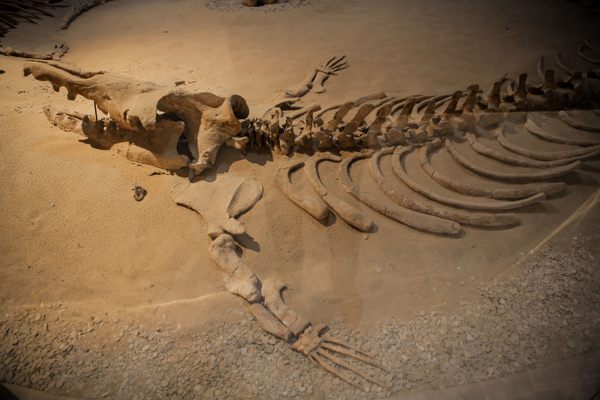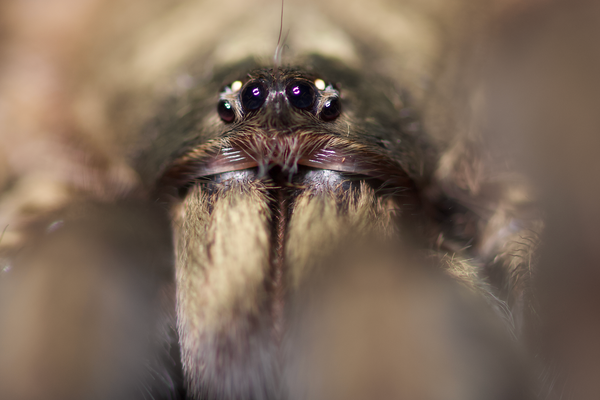The Intriguing Life, Death, and Afterlife of an Indiana Mastodon
Scientists have pieced together a detailed biography—including a search for love and a violent end.
Fred was a mama’s boy for the first third of his life. Born more than 13,000 years ago, most likely on the plains of what’s now central Indiana, the American mastodon stayed close to his mother and other females as they moved, much like elephants today, in a matriarchal herd. As Fred entered adulthood, things changed, as they often do for young males looking for love—and looking to prove themselves against the competition.
Fred established his own territory, away from the herd that raised him, and grew into a bulldozer of a beast, weighing an estimated 16,000 pounds. About as tall as a modern elephant, Fred, like other members of Mammut americanum, was much more heavily built. And he knew how to throw his weight around. In his 20s, during the warmer months when love—or at least reproduction—was in the air, Fred would get into the mastodon equivalent of spring break bar brawls, fighting with other males for the chance to hook up with an eligible bachelorette. His tusks preserved evidence of brutal, winner-take-all contests—until one of those violent battles did not go Fred’s way. At the age of 34, in the prime of life, Fred took a rival’s tusk to the face. It pierced his skull, killing him.
After he fell, his remains sank into swampy sediment. There, in the low-oxygen environment, his skeleton was so well preserved that, when peat miner Dan Buesching discovered it in 1998, even the most delicate throat and foot bones were intact—a rare find. Buesching named the skeleton after his grandfather and transferred it to the Indiana State Museum in Indianapolis, where the mastodon has been a star attraction for nearly a decade. But Fred has made even more of an impression on paleontologists, who have pieced together not just where he traveled during key periods in his life, but at what time of year, and even why.
For a paper published Monday in the journal PNAS, scientists tracked years of Fred’s seasonal travels. Combining the new information with what was previously known, in addition to data about mastodons in general and the behavior of modern elephants, the team was able to reconstruct a biography of Fred that’s nearly as complete as his skeleton. Much of the paper rests on meticulous and multi-faceted analysis of one of his tusks.

“His entire life was preserved in this one fascinating structure. I love seeing that out there,” says Georgia Southern University paleontologist Kathlyn Smith. Although Smith was not involved in the new research, she has spent years analyzing mastodon tusks—including Fred’s—for a separate project. “Simply going back and finding the story of one individual is something I’ve always really been taken by. It’s like being a wildlife biologist who’s following the same animal throughout their lifespan, but doing this with a fossil.”
The methods the team used are not new, and this isn’t the first time scientists have applied them to an individual Ice Age animal. In 2021, for example, a separate team analyzed the tusk of a 17,000-year-old woolly mammoth nicknamed Kik, and was able to recreate the animal’s general movements over its 28 years of life. The new paper on Fred, however, is the first to follow a mastodon—and the first to drill down to the seasonality of his travels, which revealed an interesting new wrinkle.
“This is a really good example of a new technique that’s been evolving, and being used in different ways,” says paleontologist Chris Widga, head curator of the Gray Fossil Site & Museum in Tennessee, who was also not involved in the paper. “We didn’t know how these mastodons were moving around landscapes, but now we’re learning individual histories.”
The scientists charted Fred’s story by analyzing multiple minute samples of a tusk. Plants absorb and store chemical signatures specific to the locations where they grow; these signatures, based on isotopes of elements such as strontium, can be mapped geographically—what scientists call an “isoscape.” Munching on spruce tips and branches as he roamed, Fred accumulated these molecular passport stamps. Because mastodon tusks never stop growing, and build up in distinct annual and seasonal layers—similar to tree rings—the tusks recorded both where and when Fred traveled.

Fred appears to have stayed in central Indiana until the age of 12. After that, as an adolescent, he moved somewhat to the north, but did not appear to make any seasonal migrations in his youth. Once he became an adult, about a decade later, there are clear signs that he fought with other males on multiple occasions.
“The evidence of fighting is there, in their tusks,” says University of Michigan paleontologist Daniel Fisher, one of the field’s leading mastodon scholars and a coauthor of the recent paper. Fisher says that long before Fred was felled by a rival, earlier damage to the tusk, including internal fractures, tells a story of frequent combat that always occurred in spring and summer months—the time of year the team has determined would have been mating season.
“This tusk was rammed into the back of its bony socket as a result of the reaction force after he’s slammed it up into an opponent,” says Fisher. “He was giving and getting the same kind of thrashing. This is not something you do in the course of feeding or digging for water. This is full body, vigorous, put-your-heart-in-it-or-you-end-up-dead contact.”
The evidence of seasonal violence points to Fred and other mastodons entering musth, a temporary state of extreme aggression associated with besting rivals to gain access to females. While male elephants today also experience musth, it’s typically in the winter months; mastodons lived in a climate with a much harsher winter than their modern relatives, however, which is one of many reasons Fisher’s team has zeroed in on spring and summer being the Ice Age animals’ time to breed. “The critical thing for this paper is that we see repeated evidence of fighting at the same time of year, and it is the time of year … when mating would be happening,” says Fisher.
The new research also reveals, based on analysis of tusk layers from his last three summers, that Fred made an annual trip to a specific area, about 100 miles northeast of his usual territory. It was there, near what’s now Fort Wayne, that Fred met his end during a musth battle that, even for modern elephants, “can end in death, for one or both combatants,” says the paper’s first author, University of Cincinnati paleoecologist Joshua Miller. Miller designed the model that made it possible for the team to analyze the complex interplay of time and location data gleaned from Fred’s tusks.
“What struck me is the level of detail [in the paper],” says Widga. “These are not easy data sets to acquire.” Widga also notes that the paper’s authors were careful to stick to the evidence and avoid speculation, always a temptation when telling the story of one individual. “It’s easy to go out on a limb and get ahead of the data,” he says. “I think they did a good job of walking the line.”
In fact, while Fisher and Miller believe Fred headed to Fort Wayne in the warm months to find a mate, they’re quick to add that there’s much more to learn about what attracted him to that specific location at that specific time in his life. Miller says that he’s particularly curious why Fred never went to the Fort Wayne area as an adolescent, especially if it was a regional hotspot for mingling. He and Fisher are also careful to note that their results are valid only for this single individual. “Fred has offered science a lot, but it’s a sample size of one at this point,” says Miller. “We’d love to explore if this is a regional mating ground, or just a place that Fred loved to go in the summer.”

For Smith, the paper is a fascinating opening to a new chapter in understanding mastodon behavior.
“You gotta start somewhere and they started with a male, but to test this we need to find out what the females were doing,” says Smith, whose work on mastodon tusks has focused on the life cycles of individual females. While she believes it’s reasonable to suggest that Fred was traveling to the Fort Wayne area to mate, she says it’s unlikely eligible females did the same. Female elephants today, for example, stay with their matriarchal herds.
“The females themselves aren’t taking a vacation to ‘Love Island,’” says Smith. “They’re not leaving for days or weeks to find a mate.” Smith says it makes sense that Fred would not return to his mother’s herd to find a mate, but it’s unclear if he instead found a new herd and returned to them each year, or if he found females from different family units in the same area. Most of all, says Smith, “I want to know what those females are doing.”
“Good science always raises more good questions,” she adds. “The method is a good one. I think it’s a question of just getting a lot of data.”
Fisher and Miller agree. “Looking at the females is a really important next step,” says Miller. “We have to do this a bunch of times.”
As for Fred, his wandering ways and fighting days are long gone. “He needs some dusting at times but he’s pretty low maintenance,” says Peggy Fisherkeller, curator of geology for the Indiana State Museum and Historic Sites. Fisherkeller was part of the team that helped preserve Fred’s bones and prepare them for exhibit. She remembers the tusks in particular were challenging to work with because they were both extremely fragile and extremely heavy—each weighs about 100 pounds. The tusks currently on display are actually casts for that reason, Fisherkeller says, but the bones on view are the real thing, including Fred’s skull and lower jaw, which together weigh more than 300 pounds.
“You know that the bones are heavy, intellectually. You know everything is really, really heavy. But, when it comes down to brass tacks, the skull is so heavy. You start thinking about the weight that this animal carried,” Fisherkeller says of the wandering, pugilistic mastodon. “He does have a personality.”




























Follow us on Twitter to get the latest on the world's hidden wonders.
Like us on Facebook to get the latest on the world's hidden wonders.
Follow us on Twitter Like us on Facebook